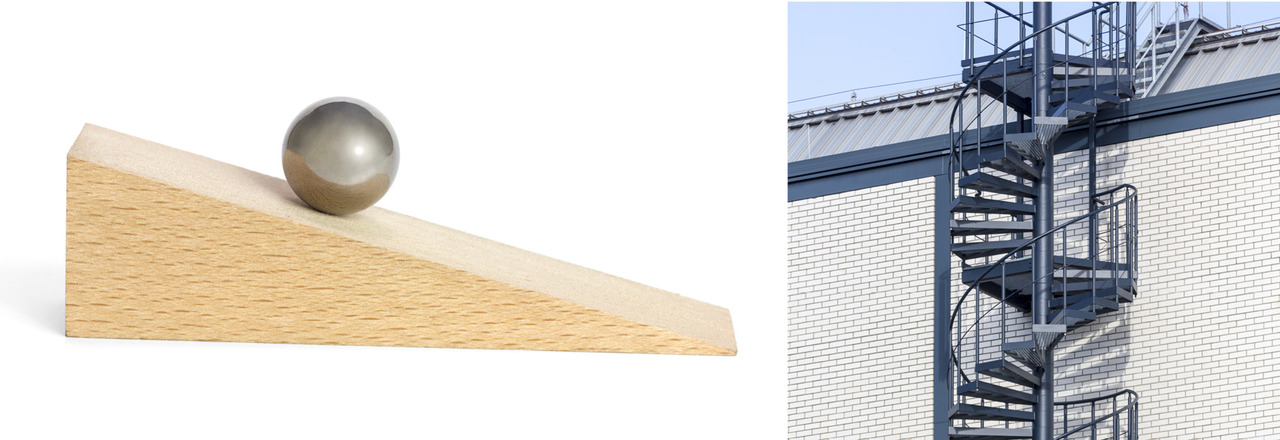31. Inclines
What is an incline?
An incline is a useful, simple device. In other words, it is a simple machine. Lifting a ball consumes more energy than rolling it up an incline does. This is why inclines are useful in many situations, for example when moving barrels and other round containers.
Stairs are an example of an incline. When climbing to the roof with ladders, the distance is shorter but the amount of energy consumed is larger. This is why stairs are useful: although they take up more space than ladders, they require less energy and effort from the person climbing them.

Image on the left: Rolling a ball up an incline saves energy. Image on the right: Stairs are an example of an incline.
A serpentine or switchback road is also a good example of an incline. A road that climbs the hill in a straight line would be too steep and require too much energy and effort. That is why a road that crosses from one side to the other is more useful. The road is longer than straight road, but it requires less energy and effort to climb.
Inclines are also used in funniculars. Lifting a group of people on the top of a steep hill takes more energy than lifting them along an incline.

Image on the left: A serpentine road is an example of an incline. This picture is from the Italian Alps. Image on the right: A funnicular is an example of an incline. This picture is from Portugal.
Wedges
When an incline is moved, it is called a wedge. Wedges can be used to split or attach things. For example, wedges can be used to split tree stumps. A splitting wedge contains two inclines, and it is hit with a hammer.
Many sharp implements that are used as tools are wedges. These include the knife, the chisel and the axe.
 Wood can be split with tools that use wedges.
Wood can be split with tools that use wedges.
A door stop can also make use of a wedge. When an incline is pushed under a door, it raises the door a little bit and is stuck under the door's weight. This helps the door to stay put.
Screws
A screw is a wedge that has been twisted around an axle. When it is rotated on a surface, it wedges itself tightly inside it.
Because screws are inclines, they can be used to lift things. For example, the function of a jack, which is a device used to lift cars in order to change their tires, is based on a screw.

A screw is a wedge that has been twisted around an axle.
A screw can also be used to split wood. A wedge-shaped screw is extremely useful for this purpose.
Because nails and screws are wedges, they are useful for splitting wood.

Because nails and screws are wedges, they are useful for splitting wood.
Teeth, claws and beaks
The teeth of some animals are wedge-shaped. For example, the human front and canine teeth are shaped like wedges. This makes them useful for cutting up pieces of food. The teeth of many predators, such as the wolf, are also wedge-shaped. They penetrate the skin of their prey easily.
The claws of many predator birds, such as the eagle, are also wedge-shaped. They are useful for digging into their prey.

Some teeth and claws are wedges. A wolf and a white-tailed eagle.
The beaks of many birds are also wedge-shaped. For example, many woodpeckers have wedge-shaped beaks. The black woodpecker (pictured below) uses its beak to peel away tree bark and cut holes in the tree when hunting for insects.

The beak of the black woodpecker is wedge-shaped.
